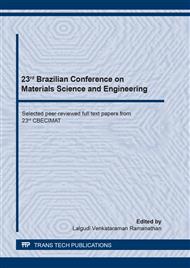p.136
p.141
p.147
p.153
p.158
p.167
p.173
p.179
p.185
Graphite Electrodes for Hydrogen Production by Acid Electrolysis
Abstract:
Nowadays, humanity has become aware of the consequences that the use of fossil fuels entails, and the latest developments in the energy sector are leading to a diversification of energy resources. In this context, researching on alternative forms of producing electric energy is being conducted. At the transportation level, a possible solution for this matter may lie in hydrogen fuel cells. The electrolysis of water is one of the possible processes for hydrogen production, but the reaction to break the water molecule requires a great amount of energy and this is precisely the biggest issue involving this process. In this work, low cost electrodes of 254 stainless steel and electrolytic graphite were used for hydrogen production, allowing high efficiency and reduced oxidation during the process. The selection of these materials allows to obtain a high corrosion resistance electrolytic pair, by replacing the high cost platinum electrode usually employed in the alkaline electrolysis process. The formic acid of biomass origin was used as an electrolyte. It was observed that the developed reactor have no energy losses through heat and it was possible to obtain approximately 82% conversion efficiency in the gas production process.
Info:
Periodical:
Pages:
158-163
Citation:
Online since:
October 2020
Keywords:
Price:
Сopyright:
© 2020 Trans Tech Publications Ltd. All Rights Reserved
Share:
Citation:


